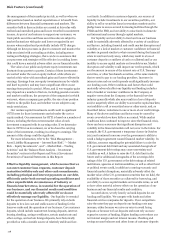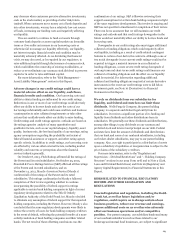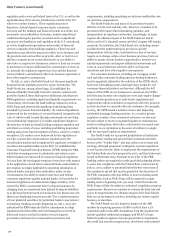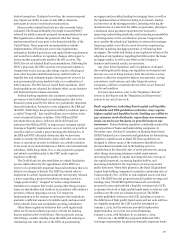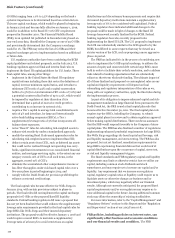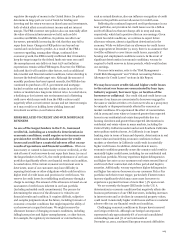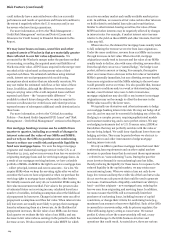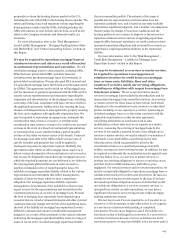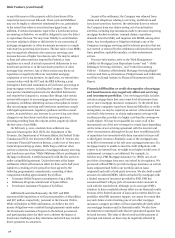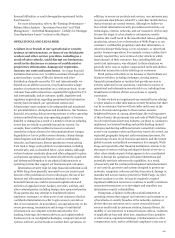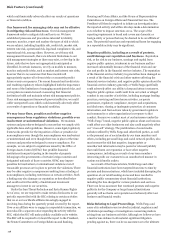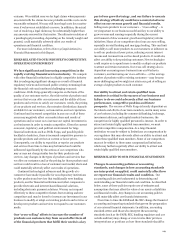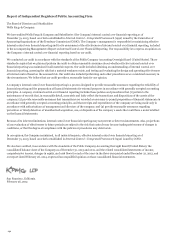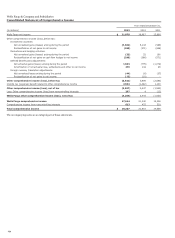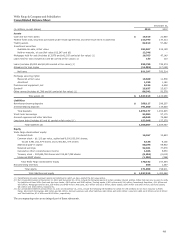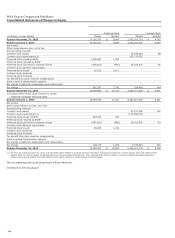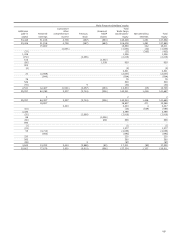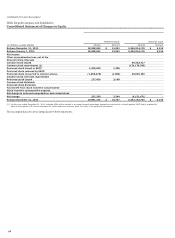Wells Fargo 2013 Annual Report Download - page 130
Download and view the complete annual report
Please find page 130 of the 2013 Wells Fargo annual report below. You can navigate through the pages in the report by either clicking on the pages listed below, or by using the keyword search tool below to find specific information within the annual report.Risk Factors (continued)
which could materially adversely affect our results of operations
or financial condition.
Our framework for managing risks may not be effective
in mitigating risk and loss to us. Our risk management
framework seeks to mitigate risk and loss to us. We have
established processes and procedures intended to identify,
measure, monitor, report and analyze the types of risk to which
we are subject, including liquidity risk, credit risk, market risk,
interest rate risk, operational risk, legal and compliance risk, and
reputational risk, among others. However, as with any risk
management framework, there are inherent limitations to our
risk management strategies as there may exist, or develop in the
future, risks that we have not appropriately anticipated or
identified. In certain instances, we rely on models to measure,
monitor and predict risks, such as market and interest rate risks,
however there is no assurance that these models will
appropriately capture all relevant risks or accurately predict
future events or exposures. The recent financial and credit crisis
and resulting regulatory reform highlighted both the importance
and some of the limitations of managing unanticipated risks, and
our regulators remain focused on ensuring that financial
institutions build and maintain robust risk management policies.
If our risk management framework proves ineffective, we could
suffer unexpected losses which could materially adversely affect
our results of operations or financial condition.
We may incur fines, penalties and other negative
consequences from regulatory violations, possibly even
inadvertent or unintentional violations. We maintain
systems and procedures designed to ensure that we comply with
applicable laws and regulations. However, some legal/regulatory
frameworks provide for the imposition of fines or penalties for
noncompliance even though the noncompliance was inadvertent
or unintentional and even though there was in place at the time
systems and procedures designed to ensure compliance. For
example, we are subject to regulations issued by the Office of
Foreign Assets Control (OFAC) that prohibit financial
institutions from participating in the transfer of property
belonging to the governments of certain foreign countries and
designated nationals of those countries. OFAC may impose
penalties for inadvertent or unintentional violations even if
reasonable processes are in place to prevent the violations. There
may be other negative consequences resulting from a finding of
noncompliance, including restrictions on certain activities. Such
a finding may also damage our reputation as described below
and could restrict the ability of institutional investment
managers to invest in our securities.
Under the Iran Threat Reduction and Syria Human Rights
Act of 2012, we are required to make certain disclosures in our
periodic reports filed with the SEC relating to certain activities
that we or our worldwide affiliates knowingly engaged in
involving Iran during the quarterly period covered by the report.
If we or an affiliate were to engage in a reportable transaction, we
must also file a separate notice regarding the activity with the
SEC, which the SEC will make publicly available on its website.
The SEC will be required to forward the report to the President,
the Senate Committees on Foreign Relations and Banking,
Housing and Urban Affairs, and the House of Representatives
Committees on Foreign Affairs and Financial Services. The
President will then be required to initiate an investigation into
the reported activity and within 180 days make a determination
as to whether to impose sanctions on us. The scope of the
reporting requirement is broad and covers any domestic or
foreign entity or person that may be deemed to be an affiliate of
ours. The potential sanctions and reputational harm for engaging
in a reportable activity may be significant.
Negative publicity, including as a result of protests,
could damage our reputation and business. Reputation
risk, or the risk to our business, earnings and capital from
negative public opinion, is inherent in our business and has
increased substantially because of the financial crisis and our
size and profile in the financial services industry. The reputation
of the financial services industry in general has been damaged as
a result of the financial crisis and other matters affecting the
financial services industry, and negative public opinion about the
financial services industry generally or Wells Fargo specifically
could adversely affect our ability to keep and attract customers.
Negative public opinion could result from our actual or alleged
conduct in any number of activities, including mortgage lending
practices, servicing and foreclosure activities, corporate
governance, regulatory compliance, mergers and acquisitions,
and disclosure, sharing or inadequate protection of customer
information, and from actions taken by government regulators
and community or other organizations in response to that
conduct. Because we conduct most of our businesses under the
“Wells Fargo” brand, negative public opinion about one business
could affect our other businesses and also could negatively affect
our “cross-sell” strategy. The proliferation of social media
websites utilized by Wells Fargo and other third parties, as well
as the personal use of social media by our team members and
others, including personal blogs and social network profiles, also
may increase the risk that negative, inappropriate or
unauthorized information may be posted or released publicly
that could harm our reputation or have other negative
consequences, including as a result of our team members
interacting with our customers in an unauthorized manner in
various social media outlets.
As a result of the financial crisis, Wells Fargo and other
financial institutions have been targeted from time to time by
protests and demonstrations, which have included disrupting the
operation of our retail banking stores and have resulted in
negative public commentary about financial institutions,
including the fees charged for various products and services.
There can be no assurance that continued protests and negative
publicity for the Company or large financial institutions
generally will not harm our reputation and adversely affect our
business and financial results.
Risks Relating to Legal Proceedings. Wells Fargo and
some of its subsidiaries are involved in judicial, regulatory and
arbitration proceedings or investigations concerning matters
arising from our business activities. Although we believe we have
a meritorious defense in all material significant litigation
pending against us, there can be no assurance as to the ultimate
128


